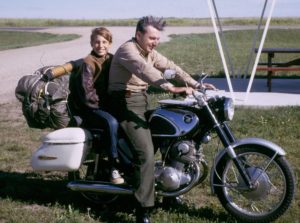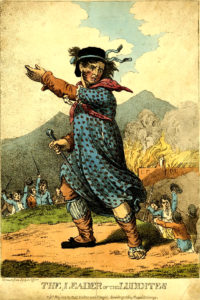Across the Great Divide
Written for the New York Times education website, January 2010

It was about a father and son traveling cross-country on a Harley Davidson, riding through the upper Midwest with a married couple following on their motorcycle. For Robert Pirsig, the trip was an opportunity to grow closer to his son, a young man on the brink of madness. But conversations are difficult at 70 miles per hour and so Pirsig turned inward.
His account of that trip, Zen and the Art of Motorcycle Maintenance, was Pirsig’s meditation on parenthood, the nature of “quality,” and what C.P. Snow called “the two cultures” of science and the humanities. The companion for the trip (John, husband of the couple) was a perfect example of the latter. When a small rattle in the engine caused Pirsig to motion for a rest stop, he sat in the grass and began analyzing the problem, discussing possible solutions. As he talked his way through the diagnosis, John’s eyes glazed. He was on the “humanities” side of the line with no interest in ever crossing over.
I read that book when I was a teen-ager and it set an agenda for my adulthood. I saw myself in John, but wanted to be more like Robert. I’ve always admired people who traveled well in both worlds, but as I lurched into maturity and became a journalist, I recognized the defining characteristic of my tribe: We don’t do math. Yet we share with mathematicians the joy of solving problems, of fixing things.
 In the intervening three decades, technology has changed that world and blurred the lines between those cultures. To succeed in my field today, technical skills with Web design and photo manipulation are in greater demand than traditional storytelling ability.
In the intervening three decades, technology has changed that world and blurred the lines between those cultures. To succeed in my field today, technical skills with Web design and photo manipulation are in greater demand than traditional storytelling ability.
And so as we face this wondrous New World Order in which technology feeds every move, it troubles me that that there are new divisions.
In the mid-1990s, as my world moved from paper (where we proudly called ourselves “ink-stained wretches”), it seemed that culturally, we were headed the wrong direction. One of the great moments in American history came in the 1830s, with the democratization of the media. Until then, newspapers were the property of the privileged class. But the “penny papers” that arrived in the 1830s suddenly put information within the reach of damn near everybody. Symbolically, the cost of citizenship was one cent. Newspapers began carrying stories about the rest of us, not just presidents and wealthy merchants. Stories of drunkenness and marital brawls made the paper. People who couldn’t read suddenly had a reason to learn. These new stories tapped into that basic human need for dirt on the neighbors. The literacy rates skyrocketed.
 In the mid-1990s, as newspapers started migrating information to the Web, I held up my hand and suggested pause. Back then, a computer cost $1,500, effectively pricing millions out of information that had been theirs for a quarter. I feared we were developing a class system of information-haves and information-have-nots.
In the mid-1990s, as newspapers started migrating information to the Web, I held up my hand and suggested pause. Back then, a computer cost $1,500, effectively pricing millions out of information that had been theirs for a quarter. I feared we were developing a class system of information-haves and information-have-nots.
I raised the issue and was immediately excoriated by critics and colleagues as a Luddite. The same thing happened a decade later when I argued in another essay that technology undercut serendipity. I suggested that when it’s so easy to find exactly what we are looking for, we miss all of those things we didn’t know we were looking for. The newspaper remains a brilliant invention for a number of reasons. Each turn of the page presents opportunities to learn something you didn’t know you were interested in. The problem with the Internet is that its efficiency – leading you immediately to what you want – undercuts the element of chance. It’s akin to browsing in a bookstore. Do we do that anymore, I wondered, when we can one-click on Amazon.com and find exactly what we want?
When that essay was picked up by the New York Times, it was – thanks to the Web – available everywhere on the globe. A few months after it appeared, I inserted my name and “serendipity” into a search engine and discovered all hell had broken loose in the blogosphere. The BBC did a story on the outrage suffered at my hands by technobloggers. My essay had infuriated techies and I was seen as one of those “humanities morons.” Cyber insults were flying and several bloggers speculated I was a knuckle-dragger who didn’t even have an e-mail address. So, of course, I e-mailed them. “I enjoyed your essay,” I began, “but you obviously know nothing about me.” I suggested that we talk about our different views of the world.
No response. Not one. None. Zilch. Nada.
And I thought: How sad. This great technology that can bring us closer together is driving us apart. I’d reached across the world to try to start a conversation with someone I’d never met, but he was more content to pound away on keys in his intellectual tower rather than talk to me.
 That article led to an invitation to speak to a group of scientists at the World Technology Summit, where we discussed the lost art of serendipity and the role that happy accident – finding something you didn’t know you were looking for – has played in both art and science. It was the kind of exchange I wanted my original article to inspire.
That article led to an invitation to speak to a group of scientists at the World Technology Summit, where we discussed the lost art of serendipity and the role that happy accident – finding something you didn’t know you were looking for – has played in both art and science. It was the kind of exchange I wanted my original article to inspire.
But the difference was that we were all in a room, looking in each other’s eyes, having a conversation. How 20th Century of me.
Think about it: We write intimate details for a world of strangers to see on
Facebook, but we don’t know our neighbor’s name. We “tweet” our most mundane activities on Twitter, yet recoil when a friendly stranger commits the sin of asking, “How’re you doing?” We pontificate ad nauseum in our little half acres of the Web, but don’t engage in any meaningful conversations with other living, breathing beings.
Facebook, My Space and other sites are called “social networking,” yet they drive people off to solitary hives behind computer keyboards, where they are anything but social. Facebook asks users to friend people they want to list on their sites as their “friends.” But are the real friends or only “Facebook Friends”?
Unfortunately, if we raise questions and look at the social impact of technology on our culture, we are immediately tossed into the don’t-get-it dustbins of mouthbreathers who “can’t accept technology.”
I accept it, understand it and embrace it. But as someone who’s spent four decades involved in the merchanting of news on this planet, I have some concerns. We live in an information-choked culture and when we allow search engines to do our thinking for us, we run the risk of building further moats to isolate us from the rest of humanity.
 When I defend newspapers and lament their demise, critics assume it’s because I can’t deal with new technology. Not at all. In the new world order, you build your own “newspaper” online through news alerts sent to your mailbox. That practice has some serious social consequences.
When I defend newspapers and lament their demise, critics assume it’s because I can’t deal with new technology. Not at all. In the new world order, you build your own “newspaper” online through news alerts sent to your mailbox. That practice has some serious social consequences.
Your news alerts breathlessly inform you of the grocery-store sightings of celebrity couples and new football recruits. Steadily, those alerts will diminish your humanity. Will you put “starvation,” “injustice” and “racism” in your news alert? Will you ask your search engine to send you stories to ignite your moral outrage, or pique your curiosity about innovation?
We will be informed of the most recent Third World celebrity adoption, but we will know nothing of the suffering in our hometown. We will be kept abreast of fashion trends, but not to prejudice. It is possible to travel through this world, considering yourself well-informed, yet never confronted with information that might irritate, anger or upset you. One of the definitions of journalism has always been to “comfort the afflicted and afflict the comforted.” Yet we allow technology to numb us to others.
We bow before technology and allow it to lead when we should instead lead technology, using it to help us have productive and useful lives. But beyond that, we need to unlock technology’s potential to make us more human, to help us become more compassionate and social. Technology can help us embrace the flesh and blood rather than celebrate and perpetuate the synthetic humanity online.
We need to motion for a rest stop, and this time, we have something bigger than a motorcycle to fix.
